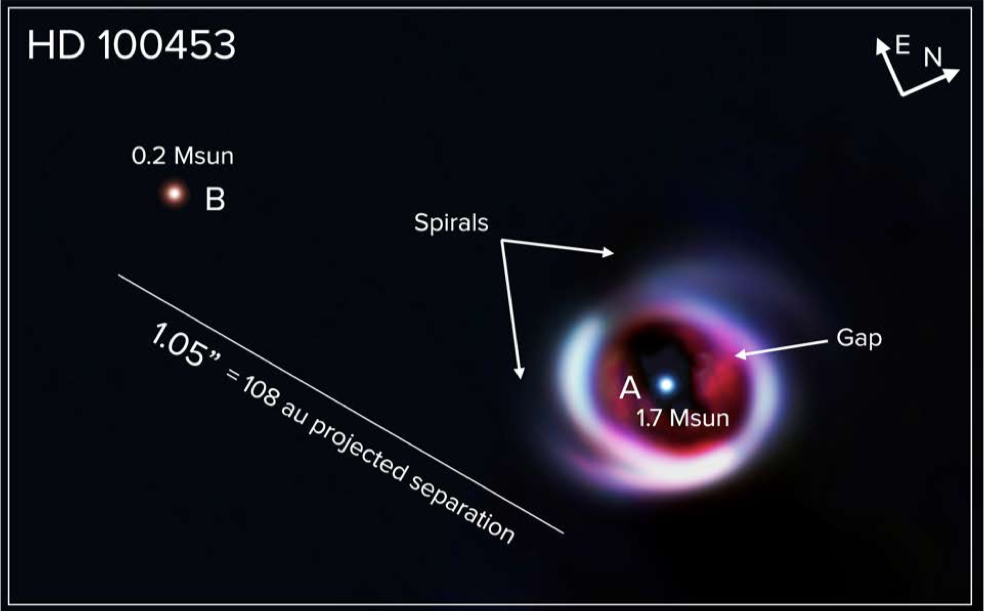A few days ago we posted a new paper on arXiv on the spectacular spiral in the HD 100453 system. The new paper, led by Steward astronomy graduate student Kevin Wagner, settles the question of the origin of the enigmatic spiral arms.
This rare two-armed spiral structure was discovered by Kevin – as a first-year graduate student – back in 2015 (and covered in a popular press release) using the SPHERE extreme adaptive optics system on the Very Large Telescope in Chile, in observations carried out in our Scorpion Survey. Strikingly, the spiral arms are about 40 times as long as the Earth-Sun separation — that is, longer than the Neptune-Sun separation in the solar system.
The spiral arms are not the only features in the system: they connect to a well-defined inner dust ring, within which there is much less dust (making this a “transition disk”). At about the location where the arms connect to the ring two darker regions are visible, which may or may not be important.
But interpreting light scattered from fine dust is always a difficult undertaking:
What do we really see on the image? Which structures are real and which are only tricks of light?
In Monet’s paintings of foggy London, tricks of light hide most of the buildings and we can recognize the city only from a few well-kown silhouettes: shapes and colors are altered and details are missing. Still, the presence of the fog itself and the change of lighting across the image in different versions of his The Houses of Parliament tell us about the scene as much as the few recognizable figures.
 Following Kevin’s discovery, the HD100453 spiral arms emerged as an immediate mystery: what process drives these structures? Explaining their presence is particularly important, because one-armed spirals are seen in an increasing number of disks and a few others now also sport two-armed disks. The arms may mark planets hidden by the dust — just like the buildings of London in Monet’s mysterious fog — or may just be a trick of light? It was proposed that shadows from in the inner, faster-orbiting disks may be projected to the outer disk, creating the illusion of structures (like the larger dark gaps where the spiral arms join the rings, and elsewhere), where none exists. Or, such shadows may also change the temperature of the outer disk (it will be cooler in the shadows), which would in turn change the overall structure of the disk, giving rise to a spiral arms as changes propagate in the disk — translating a shadow to a physical evolution in the disk.
Following Kevin’s discovery, the HD100453 spiral arms emerged as an immediate mystery: what process drives these structures? Explaining their presence is particularly important, because one-armed spirals are seen in an increasing number of disks and a few others now also sport two-armed disks. The arms may mark planets hidden by the dust — just like the buildings of London in Monet’s mysterious fog — or may just be a trick of light? It was proposed that shadows from in the inner, faster-orbiting disks may be projected to the outer disk, creating the illusion of structures (like the larger dark gaps where the spiral arms join the rings, and elsewhere), where none exists. Or, such shadows may also change the temperature of the outer disk (it will be cooler in the shadows), which would in turn change the overall structure of the disk, giving rise to a spiral arms as changes propagate in the disk — translating a shadow to a physical evolution in the disk.
The problem was that no one knew enough about the system to distinguish real geometry from tricks of light — multiple different proposed models could explain the arms seen in scattered light equally well, but differed in their assumptions of the underlying system architecture.
In our new study Kevin has used old and new observations of the system to constrain the orbit of the companion (a red dwarf star labeled B) over the past fourteen years.

Although the fourteen years is only a small fraction of the star’s orbit around the center of mass in the system, it was sufficient to constrain the plane of its orbit, which was previously unknown. Kevin then used another technique to better constrain the plane of the disk itself: as you can’t quite trust scattered light images to determine where the structures (mass) is hidden, he used longer wavelength observations from the ALMA radio interferometer array to figure out how inclined is the disk. ALMA can see through the fine dust grains and can pick up where more of the mass is located: although the images do not provide fine details, they can tell us how the disk structure is oriented.
The results are exciting: star B and the disk are orbiting in the same or nearly identical planes.
Now, with the known orientation Ruobing Dong could carry out hydrodynamical simulations of how the star and the disk would interact – even if started without spiral arms, these quickly form in the simulations and follow the morphology of the scattered light images extremely well.
These results show that no unseen planets are required to drive the spiral arms. They also provide a possible template that we may follow when interpreting other systems with spiral arms. Particularly compelling are the ones in which there is no known companion star – now, equipped with a model that reproduces a well-understood system we may be able to pinpoint the planets hiding in these disks: just like we know that the buildings of London are hiding in Monet’s paintings.

